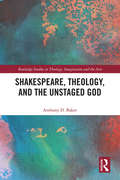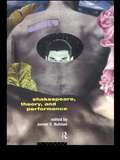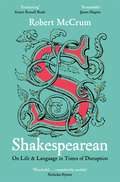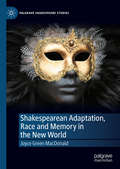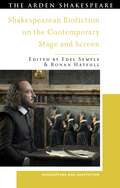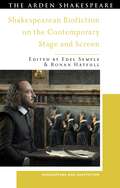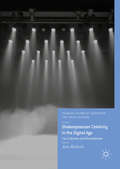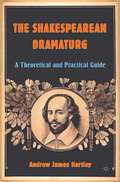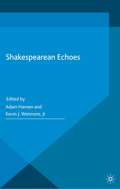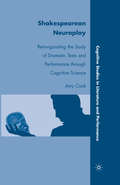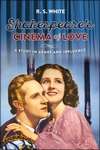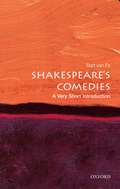- Table View
- List View
Shakespeare, Theology, and the Unstaged God (Routledge Studies in Theology, Imagination and the Arts)
by Anthony D. BakerWhile many scholars in Shakespeare and Religious Studies assume a secularist viewpoint in their interpretation of Shakespeare’s works, there are others that allow for a theologically coherent reading. Located within the turn to religion in Shakespeare studies, this book goes beyond the claim that Shakespeare simply made artistic use of religious material in his drama. It argues that his plays inhabit a complex and rich theological atmosphere, individually, by genre and as a body of work. The book begins by acknowledging that a plot-controlling God figure, or even a consistent theological dogma, is largely absent in the plays of Shakespeare. However, it argues that this absence is not necessarily a sign of secularization, but functions in a theologically generative manner. It goes on to suggest that the plays reveal a consistent, if variant, attention to the theological possibility of a divine "presence" mediated through human wit, both in gracious and malicious forms. Without any prejudice for divine intervention, the plots actually gesture on many turns toward a hidden supernatural "actor", or God. Making bold claims about the artistic and theological of Shakespeare’s work, this book will be of interest to scholars of Theology and the Arts, Shakespeare and Literature more generally.
Shakespeare, Theology, and the Unstaged God (Routledge Studies in Theology, Imagination and the Arts)
by Anthony D. BakerWhile many scholars in Shakespeare and Religious Studies assume a secularist viewpoint in their interpretation of Shakespeare’s works, there are others that allow for a theologically coherent reading. Located within the turn to religion in Shakespeare studies, this book goes beyond the claim that Shakespeare simply made artistic use of religious material in his drama. It argues that his plays inhabit a complex and rich theological atmosphere, individually, by genre and as a body of work. The book begins by acknowledging that a plot-controlling God figure, or even a consistent theological dogma, is largely absent in the plays of Shakespeare. However, it argues that this absence is not necessarily a sign of secularization, but functions in a theologically generative manner. It goes on to suggest that the plays reveal a consistent, if variant, attention to the theological possibility of a divine "presence" mediated through human wit, both in gracious and malicious forms. Without any prejudice for divine intervention, the plots actually gesture on many turns toward a hidden supernatural "actor", or God. Making bold claims about the artistic and theological of Shakespeare’s work, this book will be of interest to scholars of Theology and the Arts, Shakespeare and Literature more generally.
Shakespeare, Theory and Performance
by James C. BulmanShakespeare, Theory and Performance is a groundbreaking collection of seminal essays which apply the abstract theory of Shakespearean criticism to the practicalities of performance. Bringing together the key names from both realms, the collection reflects a wide range of sources and influences, from traditional literary, performance and historical criticism to modern cultural theory. Together they raise questions about the place of performance criticism in modern and often competing debates of cultural materialism, new historicism, feminism and deconstruction. An exciting and fascinating volume, it will be important reading for students and scholars of literary and theatre studies alike.
Shakespeare, Theory and Performance
by James C. BulmanShakespeare, Theory and Performance is a groundbreaking collection of seminal essays which apply the abstract theory of Shakespearean criticism to the practicalities of performance. Bringing together the key names from both realms, the collection reflects a wide range of sources and influences, from traditional literary, performance and historical criticism to modern cultural theory. Together they raise questions about the place of performance criticism in modern and often competing debates of cultural materialism, new historicism, feminism and deconstruction. An exciting and fascinating volume, it will be important reading for students and scholars of literary and theatre studies alike.
Shakespeare, Tragedy and Menopause: The Anxious Womb (Palgrave Shakespeare Studies)
by Victoria L. McMahonShakespeare was not only aware of the socio-cultural fears and anxieties generated by the older woman’s body but with the characterization of his tragic ageing females, Shakespeare becomes the first literary giant to explore the physiological and psychosocial condition that we have come to know as ‘menopause’. Although ‘menopause’ was not defined as a medical, physiological or sociocultural event for the early moderns, this book argues that such a medical and cultural transition can, in fact, be identified by sub-textual clues distinguished by various embodied anxieties. It explores several ageing women of the Shakespearean tragedies as they transition through this liminal menopausal period. Theoretically underscored by humoral theory, the analysis is metonymically centered upon the womb as the seat of menopausal anxiety. These menopausal undercurrents, not only permeate the dramatic action of each play, but also emanate outward to reflect the medical, physiological, cultural, social, and religious concerns generated by the ageing woman of the early modern period at large.
The Shakespeare Workbook and Video: A Practical Course for Actors (Theatre Arts Workbooks)
by David Carey Rebecca Clark CareyThe Shakespeare Workbook and Video provides a unifying approach to acting Shakespeare that is immediately applicable in the rehearsal room or classroom. It is an easy-to-use text providing practical exercises in specific aspects of Shakespeare's language such as meter, imagery, rhetoric and sound play. In each of these areas, it takes the reader through three steps: Speak the Text, Question the Text and Act the Text. Online video material provides an insight into the acting process and shows the authors teaching a workshop in their method for acting Shakespeare to a group of young actors. The Shakespeare Workbook and Video is the go-to textbook for a practical exploration of Shakespeare's canon.
The Shakespeare Workbook and Video: A Practical Course for Actors (Theatre Arts Workbooks)
by David Carey Rebecca Clark CareyThe Shakespeare Workbook and Video provides a unifying approach to acting Shakespeare that is immediately applicable in the rehearsal room or classroom. It is an easy-to-use text providing practical exercises in specific aspects of Shakespeare's language such as meter, imagery, rhetoric and sound play. In each of these areas, it takes the reader through three steps: Speak the Text, Question the Text and Act the Text. Online video material provides an insight into the acting process and shows the authors teaching a workshop in their method for acting Shakespeare to a group of young actors. The Shakespeare Workbook and Video is the go-to textbook for a practical exploration of Shakespeare's canon.
Shakespearean: On Life & Language in Times of Disruption
by Robert McCrum'I can’t think of anything better than listening to Robert McCrum talk about Shakespeare. And this enchanting book is the next best thing - like a gentle chat with a genuine expert.' Simon Russell BealeWhen Robert McCrum began his recovery from a life-changing stroke, described in My Year Off, he discovered that the only words that made sense to him were snatches of Shakespeare. Unable to travel or move as he used to, McCrum found the First Folio became his ‘book of life’, an endless source of inspiration through which he could embark on ‘journeys of the mind’, and see a reflection of our own disrupted times.An acclaimed writer and journalist, McCrum has spent the last twenty-five years immersed in Shakespeare's work, on stage and on the page. During this prolonged exploration, Shakespeare’s poetry and plays, so vivid and contemporary, have become his guide and consolation. In Shakespearean he asks: why is it that we always return to Shakespeare, particularly in times of acute crisis and dislocation? What is the key to his hold on our imagination? And why do the collected works of an Elizabethan writer continue to speak to us as if they were written yesterday?Shakespearean is a rich, brilliant and superbly drawn portrait of an extraordinary artist, one of the greatest writers who ever lived. Through an enthralling narrative, ranging widely in time and space, McCrum seeks to understand Shakespeare within his historical context while also exploring the secrets of literary inspiration, and examining the nature of creativity itself. Witty and insightful, he makes a passionate and deeply personal case that Shakespeare’s words and ideas are not just enduring in their relevance – they are nothing less than the eternal key to our shared humanity.
Shakespearean Adaptation, Race and Memory in the New World (Palgrave Shakespeare Studies)
by Joyce Green MacDonaldAs readers head into the second fifty years of the modern critical study of blackness and black characters in Renaissance drama, it has become a critical commonplace to note black female characters’ almost complete absence from Shakespeare’s plays. Despite this physical absence, however, they still play central symbolic roles in articulating definitions of love, beauty, chastity, femininity, and civic and social standing, invoked as the opposite and foil of women who are “fair”. Beginning from this recognition of black women’s simultaneous physical absence and imaginative presence, this book argues that modern Shakespearean adaptation is a primary means for materializing black women’s often elusive presence in the plays, serving as a vital staging place for historical and political inquiry into racial formation in Shakespeare’s world, and our own. Ranging geographically across North America and the Caribbean, and including film and fiction as well as drama as it discusses remade versions of Othello, Romeo and Juliet, Antony and Cleopatra, and The Taming of the Shrew, Shakespearean Adaptation, Race, and Memory in the New World will attract scholars of early modern race studies, gender and performance, and women in Renaissance drama.
Shakespearean Biofiction on the Contemporary Stage and Screen (Shakespeare and Adaptation)
by Professor Mark Thornton BurnettThis book is the first edited collection to explore Shakespeare's life as depicted on the modern stage and screen. Focusing on the years 1998-2023, it uniquely identifies a 25-year trend for depicting Shakespeare, his family and his social circle in theatre, film and television. Interrogating Shakespeare's afterlife across stage and screen media, the volume explores continuities and changes in the form since the release of Shakespeare in Love, which it positions as the progenitor of recent Shakespearean biofictions in Anglo-American culture. It traces these developments through the 21st century, from pivotal moments such as the Shakespeare 400 celebrations in 2016, up to the quatercentenary of the publication of the First Folio, whose portrait helped make the author a globally recognisable icon. The collection takes account of recent Anglo-American socio-political, cultural and literary concerns including feminism, digital media and the biopic and superhero genres. The wide variety of works discussed range from All is True and Hamnet to Upstart Crow, Bill and even The Lego Movie. Offering insights from actors, dramatists and literary and performance scholars, it considers why artists are drawn to Shakespeare as a character and how theatre and screen media mediate his status as literary genius.
Shakespearean Biofiction on the Contemporary Stage and Screen (Shakespeare and Adaptation)
by Professor Mark Thornton BurnettThis book is the first edited collection to explore Shakespeare's life as depicted on the modern stage and screen. Focusing on the years 1998-2023, it uniquely identifies a 25-year trend for depicting Shakespeare, his family and his social circle in theatre, film and television. Interrogating Shakespeare's afterlife across stage and screen media, the volume explores continuities and changes in the form since the release of Shakespeare in Love, which it positions as the progenitor of recent Shakespearean biofictions in Anglo-American culture. It traces these developments through the 21st century, from pivotal moments such as the Shakespeare 400 celebrations in 2016, up to the quatercentenary of the publication of the First Folio, whose portrait helped make the author a globally recognisable icon. The collection takes account of recent Anglo-American socio-political, cultural and literary concerns including feminism, digital media and the biopic and superhero genres. The wide variety of works discussed range from All is True and Hamnet to Upstart Crow, Bill and even The Lego Movie. Offering insights from actors, dramatists and literary and performance scholars, it considers why artists are drawn to Shakespeare as a character and how theatre and screen media mediate his status as literary genius.
Shakespearean Celebrity in the Digital Age: Fan Cultures and Remediation (Palgrave Studies in Adaptation and Visual Culture)
by Anna BlackwellThis book offers a timely examination of the relationship between Shakespeare and contemporary digital media. By focusing upon a variety of ‘Shakespearean’ individuals, groups and communities and their ‘online’ presence, the book explores the role of popular internet culture in the ongoing adaptation of Shakespeare’s plays and his general cultural standing. The description of certain performers as ‘Shakespearean’ is a ubiquitous but often throwaway assessment. However, a study of ‘Shakespearean’ actors within a broader cultural context reveals much, not only about the mutable face of British culture (popular and ‘highbrow’) but also about national identity and commerce. These performers share an online space with the other major focus of the book: the fans and digital content creators whose engagement with the Shakespearean marks them out as more than just audiences and consumers; they become producers and critics. Ultimately, Digital Shakespeareans moves beyond the theatrical history focus of related works to consider the role of digital culture and technology in shaping Shakespeare’s contemporary adaptive legacy and the means by which we engage with it.
Shakespearean Celebrity in the Digital Age: Fan Cultures and Remediation (Palgrave Studies in Adaptation and Visual Culture)
by Anna BlackwellThis book offers a timely examination of the relationship between Shakespeare and contemporary digital media. By focusing upon a variety of ‘Shakespearean’ individuals, groups and communities and their ‘online’ presence, the book explores the role of popular internet culture in the ongoing adaptation of Shakespeare’s plays and his general cultural standing. The description of certain performers as ‘Shakespearean’ is a ubiquitous but often throwaway assessment. However, a study of ‘Shakespearean’ actors within a broader cultural context reveals much, not only about the mutable face of British culture (popular and ‘highbrow’) but also about national identity and commerce. These performers share an online space with the other major focus of the book: the fans and digital content creators whose engagement with the Shakespearean marks them out as more than just audiences and consumers; they become producers and critics. Ultimately, Digital Shakespeareans moves beyond the theatrical history focus of related works to consider the role of digital culture and technology in shaping Shakespeare’s contemporary adaptive legacy and the means by which we engage with it.
The Shakespearean Death Arts: Hamlet Among the Tombs (Palgrave Shakespeare Studies)
by Grant Williams William E. EngelThis is the first book to view Shakespeare’s plays from the prospect of the premodern death arts, not only the ars moriendi tradition but also the plurality of cultural expressions of memento mori, funeral rituals, commemorative activities, and rhetorical techniques and strategies fundamental to the performance of the work of dying, death, and the dead. The volume is divided into two sections: first, critically nuanced examinations of Shakespeare’s corpus and then, second, of Hamlet exclusively as the ultimate proving ground of the death arts in practice. This book revitalizes discussion around key and enduring themes of mortality by reframing Shakespeare’s plays within a newly conceptualized historical category that posits a cultural divide—at once epistemological and phenomenological—between premodernity and the Enlightenment.
The Shakespearean Dramaturg: A Theoretical and Practical Guide
by A. HartleyThis book marries a theoretical analysis of the issues underlying the role of the dramaturg with a thorough sense of the material conditions of theatrical production, from script editing and rehearsal room interactions to the preparation of programme notes and audience lectures. Central to the project is a notion of authority defined not by text or author, but by the theatre itself. The result is a guide for the prospective dramaturg which also provides for the more general reader a unique case study of the nexus between the methods and assumptions of literary criticism and those of practical theatre.
Shakespearean Echoes (Palgrave Shakespeare Studies)
by Kevin J. Wetmore Jr.Shakespearean Echoes assembles a global cast of established and emerging scholars to explore new connections between Shakespeare and contemporary culture, reflecting the complexities and conflicts of Shakespeare's current international afterlife.
Shakespearean Neuroplay: Reinvigorating the Study of Dramatic Texts and Performance through Cognitive Science (Cognitive Studies in Literature and Performance)
by A. CookUsing Shakespeare's Hamlet as a test subject and cognitive linguistic theory of conceptual blending as a tool, Cook unravels the 'mirror held up to nature' at the center of Shakespeare's play and provides a methodology for applying cognitive science to the study of drama.
Shakespearean Stage Production: Then and Now (Routledge Library Editions: Shakespeare in Performance)
by Cécile de BankeAn absorbing and original addition to Shakespeareana, this handbook of production is for all lovers of Shakespeare whether producer, player, scholar or spectator. In four sections, Staging, Actors and Acting, Costume, Music and Dance, it traces Shakespearean production from Elizabethan times to the 1950s when the book was originally published. This book suggests that Shakespeare should be performed today on the type of stage for which his plays were written. It analyses the development of the Elizabethan stage, from crude inn-yard performances to the building and use of the famous Globe. Since the Globe saw the enactment of some of the Bard’s greatest dramas, its construction, properties, stage devices, and sound effects are reviewed in detail with suggestions on how a producer can create the same effects on a modern or reconstructed Elizabethan stage. Shakespeare’s plays were written to fit particular groups of actors. The book gives descriptions of the men who formed the acting companies of Elizabethan London and of the actors of Shakespeare’s own company, giving insights into the training and acting that Shakespeare advocated. With full descriptions and pages of reproductions, the costume section shows the types of dress necessary for each play, along with accessories and trimmings. A table of Elizabethan fabrics and colours is included. The final section explores the little-known and interesting story of the integral part of music and dance in Shakespeare’s works. Scene by scene the section discusses appropriate music or song for each play and supplies substitute ideas for Elizabethan instruments. Various dances are described – among them the pavan, gailliard, canary and courante. This book is an invaluable wealth of research, with extensive bibliographies and extra information.
Shakespearean Stage Production: Then and Now (Routledge Library Editions: Shakespeare in Performance)
by Cécile de BankeAn absorbing and original addition to Shakespeareana, this handbook of production is for all lovers of Shakespeare whether producer, player, scholar or spectator. In four sections, Staging, Actors and Acting, Costume, Music and Dance, it traces Shakespearean production from Elizabethan times to the 1950s when the book was originally published. This book suggests that Shakespeare should be performed today on the type of stage for which his plays were written. It analyses the development of the Elizabethan stage, from crude inn-yard performances to the building and use of the famous Globe. Since the Globe saw the enactment of some of the Bard’s greatest dramas, its construction, properties, stage devices, and sound effects are reviewed in detail with suggestions on how a producer can create the same effects on a modern or reconstructed Elizabethan stage. Shakespeare’s plays were written to fit particular groups of actors. The book gives descriptions of the men who formed the acting companies of Elizabethan London and of the actors of Shakespeare’s own company, giving insights into the training and acting that Shakespeare advocated. With full descriptions and pages of reproductions, the costume section shows the types of dress necessary for each play, along with accessories and trimmings. A table of Elizabethan fabrics and colours is included. The final section explores the little-known and interesting story of the integral part of music and dance in Shakespeare’s works. Scene by scene the section discusses appropriate music or song for each play and supplies substitute ideas for Elizabethan instruments. Various dances are described – among them the pavan, gailliard, canary and courante. This book is an invaluable wealth of research, with extensive bibliographies and extra information.
Shakespeare's Advice to the Players: (2nd Edition) (Absolute Classics Ser.)
by Peter HallThis is the ebook edition of Peter Hall's best-selling guide to acting Shakespeare that has sold over 10,000 copies. This is a new edition for a new generation – compact and concise with the facts, the way modern students and actors need it. The pay off the book according to Sir Peter is simple – it will make you a better actor!Shakespeare tells the actor when to go fast and when to go slow; when to pause, when to come in on cue and when to accent a word. His text is full of such clues. Shakespeare heard the lines as he wrote them. Shakespeare’s Advice to the Players makes watching or reading Shakespeare a richer experience, for audiences as well as actors.
Shakespeare's book: Essays in reading, writing and reception
by Richard Wilson Jane Rickard Richard MeekThis collection of essays is part of a new phase in Shakespeare studies. The traditional view of Shakespeare is that he was a man of the theatre who showed no interest in the printing of his plays, producing works that are only fully realised in performance. This view has recently been challenged by critics arguing that Shakespeare was a literary ‘poet-playwright’, concerned with his readers as well as his audiences. Shakespeare’s Book offers a vital contribution to this critical debate, and examines its wider implications for how we conceive of Shakespeare and his works. Bringing together an impressive group of international Shakespeare scholars, the volume explores both Shakespeare’s relationship with actual printers, patrons, and readers, and the representation of writing, reading, and print within his works themselves.
Shakespeare's cinema of love: A study in genre and influence (PDF)
by R. S. WhiteShakespeare's cinema of love addresses the question, how much has Shakespeare influenced modern film genres? Convincing arguments are made for the links between his comedies of love and genres such as 'screwball' comedy, musicals, romantic comedy and tragic love films.
Shakespeare's cinema of love: A study in genre and influence
by R. S. WhiteShakespeare's cinema of love addresses the question, how much has Shakespeare influenced modern film genres? Convincing arguments are made for the links between his comedies of love and genres such as 'screwball' comedy, musicals, romantic comedy and tragic love films.
Shakespeare's Comedies: A Very Short Introduction (Very Short Introductions)
by Bart van EsFrom The Two Gentlemen of Verona in the early 1590s to The Two Noble Kinsmen at the end of his career around 1614, Shakespeare wrote at least eighteen plays that can be called 'comedies': a far higher number than that for any other genre in which he wrote. So what is a Shakespearean comedy? We associate these plays with such themes as mistaken identities, happy marriages, and exuberant cross dressing, but how representative are these of the oeuvre as a whole? In this Very Short Introduction, Bart van Es explores the full range of the playwright's comic writing, from the neat classical plotting of early works like The Comedy of Errors to the corrupt world of the so-called problem plays, written in the middle years of Shakespeare's life. Examining Shakespeare's influences and sources, van Es compares his plays to those of his rivals, and looks at the history of the plays in performance, from the biographies of Shakespeare's original actors to the plays' endless reinvention in modern stage productions and in films. Identifying the key qualities that make Shakespearean comedy distinctive, van Es traces the changing nature of Shakespeare's comic writing over the course of a career that spanned nearly a quarter century of theatrical change. ABOUT THE SERIES: The Very Short Introductions series from Oxford University Press contains hundreds of titles in almost every subject area. These pocket-sized books are the perfect way to get ahead in a new subject quickly. Our expert authors combine facts, analysis, perspective, new ideas, and enthusiasm to make interesting and challenging topics highly readable.
Shakespeare's Comedies: A Very Short Introduction (Very Short Introductions)
by Bart van EsFrom The Two Gentlemen of Verona in the early 1590s to The Two Noble Kinsmen at the end of his career around 1614, Shakespeare wrote at least eighteen plays that can be called 'comedies': a far higher number than that for any other genre in which he wrote. So what is a Shakespearean comedy? We associate these plays with such themes as mistaken identities, happy marriages, and exuberant cross dressing, but how representative are these of the oeuvre as a whole? In this Very Short Introduction, Bart van Es explores the full range of the playwright's comic writing, from the neat classical plotting of early works like The Comedy of Errors to the corrupt world of the so-called problem plays, written in the middle years of Shakespeare's life. Examining Shakespeare's influences and sources, van Es compares his plays to those of his rivals, and looks at the history of the plays in performance, from the biographies of Shakespeare's original actors to the plays' endless reinvention in modern stage productions and in films. Identifying the key qualities that make Shakespearean comedy distinctive, van Es traces the changing nature of Shakespeare's comic writing over the course of a career that spanned nearly a quarter century of theatrical change. ABOUT THE SERIES: The Very Short Introductions series from Oxford University Press contains hundreds of titles in almost every subject area. These pocket-sized books are the perfect way to get ahead in a new subject quickly. Our expert authors combine facts, analysis, perspective, new ideas, and enthusiasm to make interesting and challenging topics highly readable.
